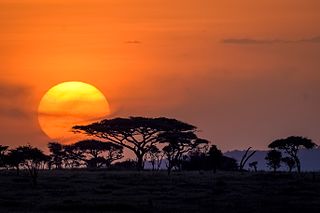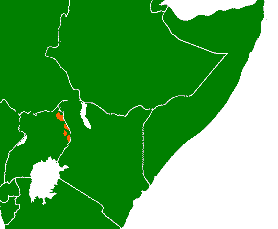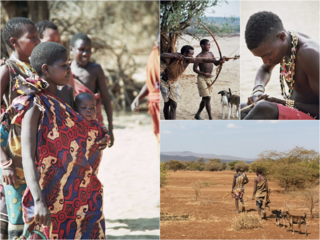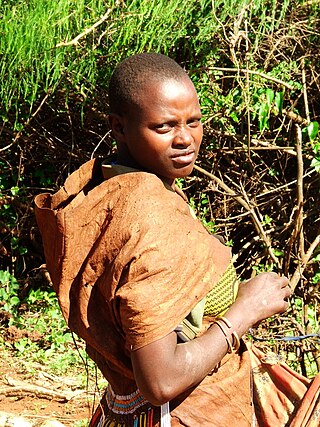
The Maasai are a Nilotic ethnic group inhabiting northern, central and southern Kenya and northern Tanzania. They are among the best-known local populations internationally due to their residence near the many game parks of the African Great Lakes and their distinctive customs and dress. The Maasai speak the Maa language, a member of the Nilotic language family that is related to the Dinka, Kalenjin and Nuer languages. Except for some elders living in rural areas, most Maasai people speak the official languages of Kenya and Tanzania, Swahili and English. The Maasai population has been reported as numbering 1,189,522 in Kenya in the 2019 census, compared to 377,089 in the 1989 census, though many Maasai view the census as government meddling and therefore either refuse to participate or actively provide false information. Many Maasai tribes throughout Tanzania and Kenya welcome visitors to their villages to experience their culture, traditions, and lifestyle, in return for a fee.

The Serengeti ecosystem is a geographical region in Africa, spanning the Mara and Arusha Regions of Tanzania. The protected area within the region includes approximately 30,000 km2 (12,000 sq mi) of land, including the Serengeti National Park and several game reserves. The Serengeti hosts the second largest terrestrial mammal migration in the world, which helps secure it as one of the Seven Natural Wonders of Africa, and as one of the ten natural travel wonders of the world.
The Nilotic peoples are people indigenous to the Nile Valley who speak Nilotic languages. They inhabit South Sudan, Sudan, Egypt, Ethiopia, Uganda, Kenya, the Democratic Republic of the Congo, Rwanda, Burundi and Tanzania. Among these are the Burun-speaking peoples, Karo peoples, Luo peoples, Ateker peoples, Kalenjin peoples, Datooga, Dinka, Nuer, Atwot, Lotuko, and the Maa-speaking peoples.

The Ngorongoro Conservation Area is a protected area and a UNESCO World Heritage Site located in Ngorongoro District, 180 km (110 mi) west of Arusha City in Arusha Region, within the Crater Highlands geological area of northern Tanzania. The area is named after Ngorongoro Crater, a large volcanic caldera within the area. The Ngorongoro Conservation Area Authority administers the conservation area, an arm of the Tanzanian government, and its boundaries follow the boundary of the Ngorongoro District in Arusha Region. The western portion of the park abuts the Serengeti National Park, and the area comprising the two parks and Kenya's Maasai Mara game reserve is home to Great Migration, a massive annual migration of millions of wildebeest, zebras, gazelles, and other animals. The conservation area also contains Olduvai Gorge, one of the most important paleoanthropological sites in the world.
The Eastern Nilotic languages are one of the three primary branches of the Nilotic languages, themselves belonging to the Eastern Sudanic subfamily of Nilo-Saharan; they are believed to have begun to diverge about 3,000 years ago, and have spread southwards from an original home in Equatoria in South Sudan. They are spoken across a large area in East Africa, ranging from Equatoria to the highlands of Tanzania. Their speakers are mostly cattle herders living in semi-arid or arid plains.
Dorobo is a derogatory umbrella term for several unrelated hunter-gatherer groups of Kenya and Tanzania. They comprised client groups to the Maasai and did not practice cattle pastoralism.
The Southern Nilotic languages are spoken mainly in western Kenya and northern Tanzania. They form a division of the larger Nilotic language family, along with the Western Nilotic languages and the Eastern Nilotic languages.
Ogiek is a Southern Nilotic language of the Kalenjin family spoken or once spoken by the Ogiek peoples, scattered groups of hunter-gatherers in Southern Kenya and Northern Tanzania. Most Ogiek speakers have assimilated to cultures of surrounding peoples: the Akiek in northern Tanzania now speak Maasai and the Akiek of Kinare, Kenya now speak Gikuyu. Ndorobo is a term considered derogatory, occasionally used to refer to various groups of hunter-gatherers in this area, including the Ogiek.

The Kuliak languages, also called the Rub languages, are a group of languages spoken by small relict communities in the mountainous Karamoja region of northeastern Uganda.
Kipsigis is part of the Kenyan Kalenjin dialect cluster, It is spoken mainly in Kericho and Bomet counties in Kenya. The Kipsigis people are the most numerous tribe of the Kalenjin in Kenya, accounting for 60% of all Kalenjin speakers. Kipsigis is closely related to Nandi, Keiyo, South Tugen (Tuken), and Cherangany.

Maasai or Maa is an Eastern Nilotic language spoken in Southern Kenya and Northern Tanzania by the Maasai people, numbering about 800,000. It is closely related to the other Maa varieties: Samburu, the language of the Samburu people of central Kenya, Chamus, spoken south and southeast of Lake Baringo ; and Parakuyu of Tanzania. The Maasai, Samburu, il-Chamus and Parakuyu peoples are historically related and all refer to their language as ɔl Maa. Properly speaking, "Maa" refers to the language and the culture and "Maasai" refers to the people "who speak Maa."
The Yaaku are a people who are said to have lived in regions of southern Ethiopia and central Kenya, possibly through to the 18th century. The language they spoke is today called Yaakunte. The Yaaku assimilated a hunter-gathering population, whom they called Mukogodo, when they first settled in their place of origin and the Mukogodo adopted the Yaakunte language. However, the Yaaku were later assimilated by a food producing population and they lost their way of life. The Yaakunte language was kept alive for sometime by the Mukogodo who maintained their own hunter-gathering way of life, but they were later immersed in Maasai culture and adopted the Maa language and way of life. The Yaakunte language is today facing extinction but is undergoing a revival movement. In the present time, the terms Yaaku and Mukogodo, are used to refer to a population living in Mukogodo forest west of Mount Kenya.

The Okiek, sometimes called the Ogiek or Akiek, are a Southern Nilotic ethnic group native to Tanzania and Southern Kenya, and Western Kenya. In 2019 the ethnic Okiek population was 52,596, although the number of those speaking the Akiek language was as low as 500.

The Hadza, or Hadzabe, are a protected Hunter-gatherer Tanzanian indigenous ethnic group from Baray ward in southwest Karatu District of Arusha Region. They live around Lake Eyasi basin in the central Rift Valley and in the neighboring Serengeti Plateau. There are, as of 2015, between 1,200 and 1,300 Hadza people living in Tanzania, however only around 400 Hadza still survive exclusively based on the traditional means of foraging. Additionally, the increasing impact of tourism and encroaching pastoralists pose serious threats to the continuation of their traditional way of life.

The Barabaig are a nomadic tribe of the Datooga people based in the northern volcanic highlands near Mount Hanang in Manyara Region, Tanzania, speaking the eponymous dialect of the Datooga language. Their population is about 50,000.
Datooga is a Nilotic language or dialect cluster of the Southern Nilotic group. It is spoken by the Datooga people of the Great Rift Valley of Tanzania. The Sukuma name Taturu is also sometimes used in English; the Swahili name Mang'ati comes from Maasai, where it means "enemy". However, it is not considered offensive to the Datooga, as there is a degree of pride in being the historic enemy of the Maasai, and Mang'ati has become the standard name for the group in Swahili. In addition, numerous tribal and dialectal names may be found for the people or language as a whole.
David William Lister Read was an author of autobiographical works which reveal a profound knowledge of Maasai history. He lived the life of a "white Maasai" and could speak their language before his own native English. Born in Nairobi, Read spent his formative years in what is now Tanzania, a country to which he would always return. Read spent his final years in Momella near Arusha in northern Tanzania, where he continued to work on his writing until his death.
The Kalenjin people are an ethnolinguistic group indigenous to East Africa, with a presence, as dated by archaeology and linguistics, that goes back many centuries. Their history is therefore deeply interwoven with those of their neighboring communities as well as with the histories of Kenya, Uganda, Tanzania, South Sudan, and Ethiopia.
Omaio (Omaiyo) is an obscure Dorobo language of Tanzania. According to interviews with speakers, the people were expelled from the Serengeti in the 1950s to make way for the park. As of 2018, three speakers remember some words of the language, though it had not been spoken since they were children. Based on the few hundred words and phrases that have been collected, the language has not been classified. There is evidence of words that can be traced to contact with speakers of the Maa and Datooga languages, as well as older words from the Southern Nilotic family which may have been inherited or borrowed.
The Mukogodo, are a people who are said to have lived in regions of central Kenya around Mt. Kenya, possibly through to the 18th century. A community known as the Yaaku later moved into their territory and the Mukogodo, adopted the Yaaku language, referred to as Yaakunte. The Yaaku community was later assimilated by a food producing population and they lost their way of life. Their language, Yaakunte, was kept alive for some time by the Mukogodo who had all along maintained their own hunter-gathering way of life. However, the Mukogodo were later assimilated by the Maasai and adopted the Maa language. The Yaakunte language is today facing extinction but is undergoing a revival movement. In the present time, the terms Yaaku and Mukogodo, are used to refer to a population living in Mukogodo forest west of Mount Kenya.







